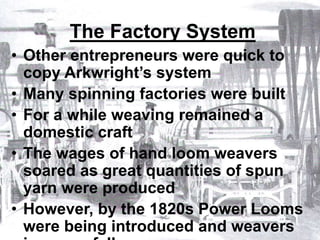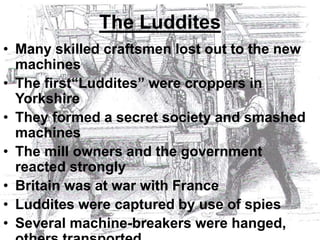textiles.ppt
- 1. The Industrial Revolution Changes in the Textile Industry
- 2. The Domestic System âĒ Before the Industrial Revolution, the production of Woollen Cloth was Britainâs most important manufacturing industry âĒ Cloth making was centred in areas where sheep farming was common: Yorkshire, the Cotswolds, Devon âĶ âĒ The main processes â carding, spinning and weaving were carried out in the cottages of workers âĒ This was known as the Carding Spinning Weaving
- 3. How did the Domestic System work? âĒ A merchant delivered wool to the workersâ homes âĒ Children carded (untangled) the wool âĒ Women and girls spun the wool into yarn using a spinning wheel âĒ Men wove the yarn into cloth on a loom âĒ The merchant took the cloth to other workers for stretching, dyeing, and cropping
- 4. Advantages and Disadvantages of the Domestic System âĒ Advantages 1. It was convenient for workers who could stay at home, work at their own pace and mind the children 2. Their earnings from spinning and weaving were extra to the living they were making from working the land (open field system) 3. Some workers were quite skilled and produced a good quality product âĒ Disadvantages 1. The quality of cloth varied from worker to worker 2. The system wasted the merchantâs time 3. Production was slow 4. Workers could cheat the merchant 5. The merchant could cheat the workers 6. âPiece-ratesâ could be very low 7. Cottages were often dirty, badly-lit and poorly
- 5. Why was there a Revolution in the textile industry? âĒ The population was growing rapidly âĒ There was an increase in the demand for better quality cloth âĒ The price of raw cotton fell as more was imported from the slave plantations of USA (after 1776) âĒ New machines were invented which speeded up the working of cotton
- 6. New Technology âĒ Spinning âĒ 1764 James Hargreaves invented âSpinning Jennyâ âĒ 1769 Sir Richard Arkwright invented âWater Frameâ âĒ 1779 Samuel Crompton invented âSpinning Muleâ (so-called because it combined the best of the Jenny and the Frame) â became the most âĒ Weaving âĒ 1733 John Kay invented âFlying Shuttleâ âĒ 1785 Edmund Cartwright invented âPower âĒHand power âĒWater power â leads to building of first mills or âFactoriesâ âĒJames Wattâs Steam Engine- form 1770sâĶ
- 7. James Hargreaves and the Spinning Jenny 1764 âĒ This was the first of the new spinning machines âĒ The first models produced thread on 8 spindles at once (instead of 1) âĒ Probably called âJennyâ meaning âGinâ,or âGinnyâ short for engine (not after his wife!) âĒ Angry spinners smashed up Hargreavesâ home in Blackburn âĒ Designed for use in domestic system
- 8. Sir Richard Arkwright 1732- 92 âĒ One of the great entrepreneurs of the Industrial Revolution âĒ His âWater Frameâwas the first machine to be designed as a âfactoryâ machine â driven by water power âĒ The âFactory Ageâ began with Arkwrightâs mill at Cromford, Derbyshire âĒ He devised the âFactory Systemâ âĒ Employed thousands of workers âĒ Patented his machine âĒ Made a huge fortune
- 9. The Factory System âĒ Other entrepreneurs were quick to copy Arkwrightâs system âĒ Many spinning factories were built âĒ For a while weaving remained a domestic craft âĒ The wages of hand loom weavers soared as great quantities of spun yarn were produced âĒ However, by the 1820s Power Looms were being introduced and weavers
- 10. The Luddites âĒ Many skilled craftsmen lost out to the new machines âĒ The firstâLudditesâ were croppers in Yorkshire âĒ They formed a secret society and smashed machines âĒ The mill owners and the government reacted strongly âĒ Britain was at war with France âĒ Luddites were captured by use of spies âĒ Several machine-breakers were hanged,
- 11. The Importance of Manchester (and Southern Lancashire) âĒ Manchester and Southern Lancashire became the main location for the Cotton Industry because:- 1. The climate was damp â ideal for working cotton 2. It was close to the port of Liverpool â the main port for trade with the USA and imports of raw cotton 3. There were skilled spinners and weavers just across the Pennines in the Yorkshire woollen industry 4. The Pennines supplied fast-flowing streams
- 12. Conclusions âĒ The development of the Factory System massively increased the amount of cotton cloth produced âĒ A new class of âentrepreneursâ made great fortunes âĒ Towns and cities grew up around the new factories â the process of âUrbanisationâ- living conditions and public health worsened âĒ Working conditions were very different in the factories to the old Domestic System












